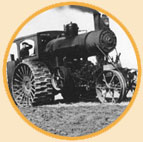The Dry Land
Challenge
 When the
homesteaders came to Alberta, they came to grow wheat. By 1900, new tillage
procedures aimed at conserving water, a recognition of the importance of weed
control, and regular pickling of seed grain to prevent smut soon permitted wheat
monoculture in many parts of Alberta. Applying genetic principles to seed
selection had produced grain varieties better suited to Alberta's climate: they
matured in a shorter time while maintaining their high protein content. When the
homesteaders came to Alberta, they came to grow wheat. By 1900, new tillage
procedures aimed at conserving water, a recognition of the importance of weed
control, and regular pickling of seed grain to prevent smut soon permitted wheat
monoculture in many parts of Alberta. Applying genetic principles to seed
selection had produced grain varieties better suited to Alberta's climate: they
matured in a shorter time while maintaining their high protein content.
The new settlers
found their farming techniques did not necessarily transfer easily to the new
land. Those from wetter Ontario or American climates needed help to
conserve the moisture in their soil in the drier Alberta climate. During the
first two decades of the twentieth century, plowing and its related tillage
practices were modified to take moisture conservation more fully into account.
The development of dryland farming techniques, which many believed would help
retain moisture in the soil, was thought to be the answer.
 The plow
remained the principal implement for land breaking and soil preparation. It was
generally agreed that prairie sod should be plowed in shallow furrows in the
spring. Furrows should not be deeper than four inches, and the sods should be
turned over and flattened with a packer or heavy roller. These sods should be
diced down to a depth of two or three inches, then harrowed with a
slanted-tooth type harrow to prepare a seedbed on the packed and pulverized
sods. Opinions varied as to the optimal timing and techniques by which this
result could be most efficiently realized. However, by about 1910, this was the
preferred dryland tillage technique. The plow
remained the principal implement for land breaking and soil preparation. It was
generally agreed that prairie sod should be plowed in shallow furrows in the
spring. Furrows should not be deeper than four inches, and the sods should be
turned over and flattened with a packer or heavy roller. These sods should be
diced down to a depth of two or three inches, then harrowed with a
slanted-tooth type harrow to prepare a seedbed on the packed and pulverized
sods. Opinions varied as to the optimal timing and techniques by which this
result could be most efficiently realized. However, by about 1910, this was the
preferred dryland tillage technique.
Kenneth Tingley. Steel and Steam: Aspects of Breaking Land in Alberta. n.p.: Friends of Reynolds-Alberta
Museum Society and Alberta Culture and Multiculturalism, Historic Sites and
Archives Service, 1992. With permission from
Friends
of Reynolds-Alberta Museum.
 
|
|
 Heritage Community Foundation Presents
Heritage Community Foundation Presents






